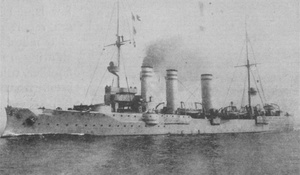Fanning Raid
| Fanning Raid | |||||||
|---|---|---|---|---|---|---|---|
| Part of World War I | |||||||
 SMS Nurnberg | |||||||
| |||||||
| Belligerents | |||||||
|
|
| ||||||
| Commanders and leaders | |||||||
|
| |||||||
| Strength | |||||||
| 1 light cruiser | |||||||
| Casualties and losses | |||||||
|
Communications station destroyed. 2000 pounds in material damage. | none | ||||||
The Fanning Raid was an action of the First World War involving a successful German attack on the Fanning island cable relay station. Vice Admiral Maximilian von Spee sent the light cruiser SMS Nürnberg along with the collier Titania to attack the station on 7 September 1914 while his East Asia Squadron was crossing the Pacific, en route to South America.
Background
Fanning island was annexed by Great Britain in 1888. The British communications company, Cable and Wireless, built a relay station for its central Pacific underwater telegraph cable on the island. The station was a part of the All Red Line. Connecting Australia, New Zealand, and Canada to Great Britain.[1]
At the outbreak of World War I in August 1914, the German East Asia Squadron, commanded by Vice Admiral Maximilian von Spee, departed from its base at Tsingtao (Qingdao). Spee intended to take his ships to South America, where British merchant shipping might be easily raided.[2] While crossing the Pacific on 6 September, Spee detached the light cruiser SMS Nürnberg and the collier Titania to investigate the British installation at Fanning and to destroy the wireless station there.[3]
Raid
In the early morning of 7 September 1914, the German cruiser SMS Nürnberg, approached Fanning flying a French flag. Noticing the French flag the staff hoisted a British flag on the flagstaff. By the time the employees noticed the deception, German sailors already landed on the island. Shortly before being arrested operators managed to send a warning to Suva: "It's the Nürnberg; they are firing."[4]
The Germans then severely damaged the cable station, rendering it inoperable, and cut the island's undersea communications cables. They also smashed spare parts and instruments. The engine was completely destroyed with the use of small arms fire and explosives.[5] Documentation as well as a cache of rifles and ammunition was confiscated. The flagstaff was also cut down. Material damage totaled £2000.[4]
Communication was reestablished in two weeks.[1]
Footnotes
- 1 2 "Fanning Island History". Retrieved 26 August 2014.
- ↑ Herwig, pp. 155–156
- ↑ Halpern, p. 88
- 1 2 "Australian Newspaper Article". Retrieved 26 August 2014.
- ↑ "Cable War" (PDF). Retrieved 26 August 2014.
References
- Halpern, Paul G. (1995). A Naval History of World War I. Annapolis, MD: Naval Institute Press. ISBN 1-55750-352-4.
- Herwig, Holger (1980). "Luxury" Fleet: The Imperial German Navy 1888–1918. Amherst, NY: Humanity Books. ISBN 978-1-57392-286-9.
Further reading
- Gray, J.A.C. Amerika Samoa, A History of American Samoa and its United States Naval Administration. Annapolis: United States Naval Institute. 1960.
Coordinates: 53°28′S 55°04′W / 53.467°S 55.067°W